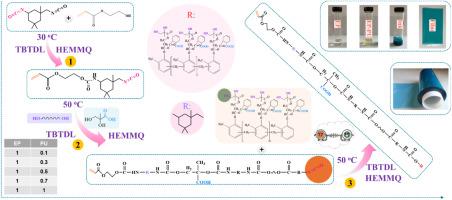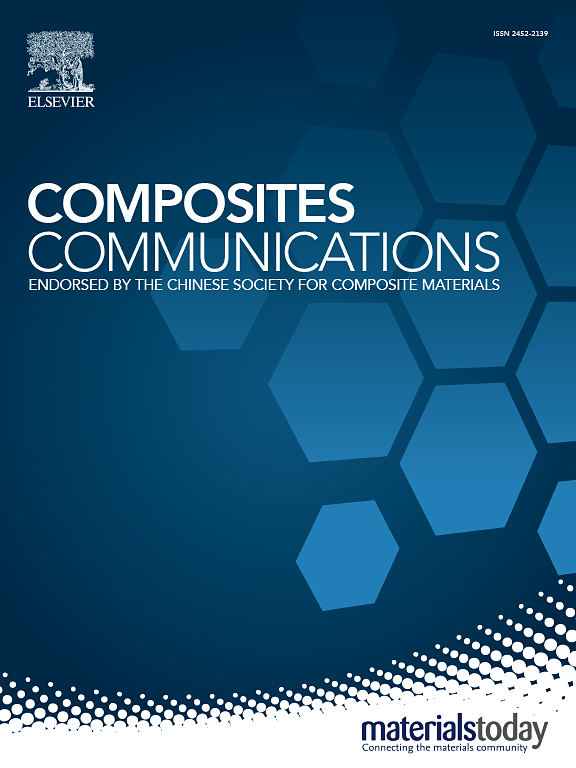High-reliable polyurethane modified epoxy photosensitive composites for solder resist applications
IF 6.5
2区 材料科学
Q1 MATERIALS SCIENCE, COMPOSITES
引用次数: 0
Abstract
Developing solder resist ink (SR) with superior comprehensive performance through the chemical modification of epoxy resin (EP) using polyurethane oligomers (PU) is an effective strategy. In this study, a highly reliable SR was designed by chemically grafting -NCO terminated PU onto the -OH groups of the EP molecular chain. By adjusting the PU content, high flexibility, reliability, and adhesion of the EP-PU system were achieved. Compared to SR-0, when the PU content is 50 % of EP, under conditions of 85 % humidity, 130 °C temperature, and 1 V voltage, the failure time of SR-0.5 can be adjusted from 67.5 h to over 150 h, an increase of 150 %. This high-reliability characteristic makes it potentially useful in applications such as printed circuit board and packaging substrate manufacturing. Additionally, by adjusting the PU content in the EP-PU system, the degree of crosslinking in the EP-PU molecular chain can be controlled, resulting in excellent adhesion, alkali resistance, hydrophobicity, mechanical properties, low water absorption, and good thermal stability. The chemical modification of EP with PU provides a theoretical basis and technical support for the development of high-performance SR, while also offering more reliable material solutions for the advancement of the electronics industry.

用于阻焊应用的高可靠性聚氨酯改性环氧光敏复合材料
通过使用聚氨酯低聚物(PU)对环氧树脂(EP)进行化学改性,开发综合性能优异的阻焊油墨(SR)是一种有效的策略。在这项研究中,通过将 -NCO 端 PU 化学接枝到 EP 分子链的 -OH 基团上,设计出了一种高可靠性的阻焊油墨。通过调整聚氨酯的含量,实现了 EP-PU 系统的高柔韧性、可靠性和粘附性。与 SR-0 相比,当 PU 含量为 EP 的 50%时,在湿度为 85%、温度为 130℃、电压为 1 V 的条件下,SR-0.5 的失效时间可从 67.5 小时调整到 150 小时以上,增加了 150%。这种高可靠性特性使其在印刷电路板和包装基板制造等应用中大有可为。此外,通过调整 EP-PU 系统中的聚氨酯含量,可以控制 EP-PU 分子链的交联程度,从而获得优异的粘附性、耐碱性、疏水性、机械性能、低吸水性和良好的热稳定性。EP 与 PU 的化学改性为高性能 SR 的开发提供了理论基础和技术支持,同时也为电子工业的发展提供了更可靠的材料解决方案。
本文章由计算机程序翻译,如有差异,请以英文原文为准。
求助全文
约1分钟内获得全文
求助全文
来源期刊

Composites Communications
Materials Science-Ceramics and Composites
CiteScore
12.10
自引率
10.00%
发文量
340
审稿时长
36 days
期刊介绍:
Composites Communications (Compos. Commun.) is a peer-reviewed journal publishing short communications and letters on the latest advances in composites science and technology. With a rapid review and publication process, its goal is to disseminate new knowledge promptly within the composites community. The journal welcomes manuscripts presenting creative concepts and new findings in design, state-of-the-art approaches in processing, synthesis, characterization, and mechanics modeling. In addition to traditional fiber-/particulate-reinforced engineering composites, it encourages submissions on composites with exceptional physical, mechanical, and fracture properties, as well as those with unique functions and significant application potential. This includes biomimetic and bio-inspired composites for biomedical applications, functional nano-composites for thermal management and energy applications, and composites designed for extreme service environments.
 求助内容:
求助内容: 应助结果提醒方式:
应助结果提醒方式:


